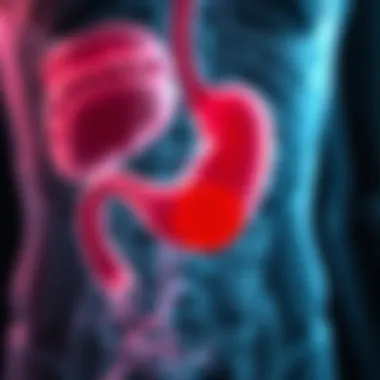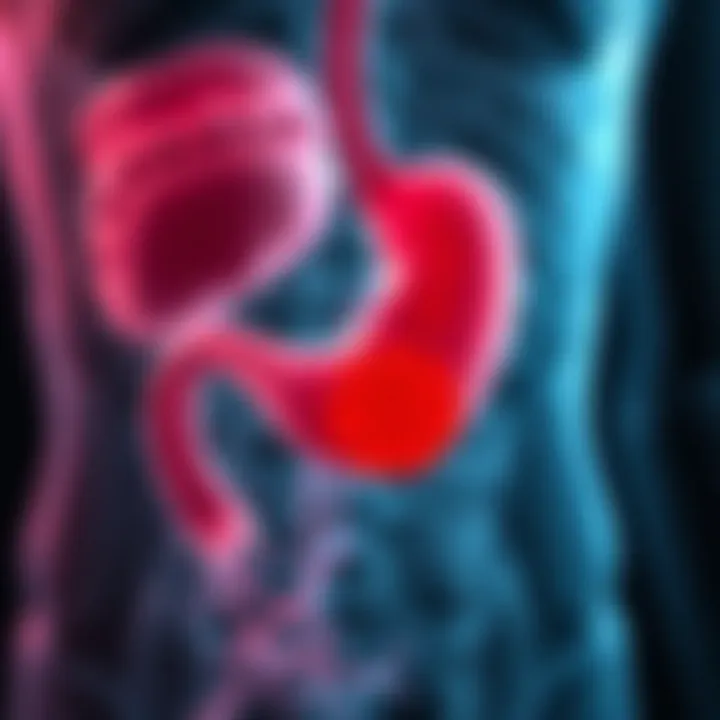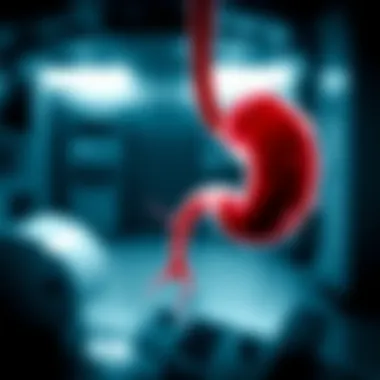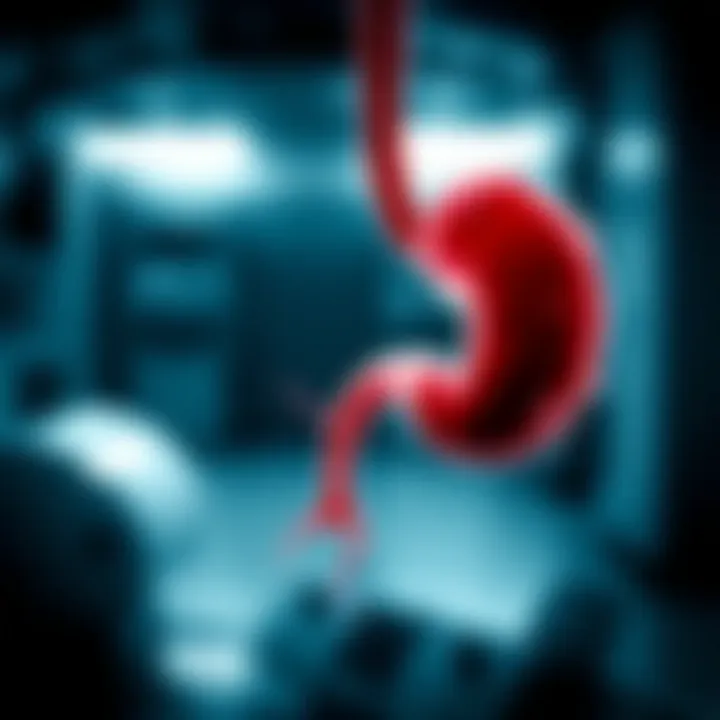Comprehensive Strategies for H. Pylori Infection Management


Article Overview
Purpose of the Article
This article aims to delve into the intricacies surrounding H. pylori infections, particularly focusing on the bacterium Helicobacter pylori, its effects on gastrointestinal health, and the myriad of treatment pathways available. Through a thorough investigation, we will explore the bacterium's role in conditions like gastritis and peptic ulcers. Additionally, we will cover both conventional medical treatments and lifestyle modifications that can aid in managing these infections effectively.
Relevance to Multiple Disciplines
H. pylori research intersects numerous academic fields, spanning microbiology, gastroenterology, nutrition, and public health. By understanding H. pylori's implications not only within medical settings but also in everyday life, individuals from various disciplines—be it healthcare professionals, researchers, or students—can enhance their comprehension of gastrointestinal health and the importance of effective infection management.
Research Background
Historical Context
Discovering the role of H. pylori in gastrointestinal disease was a significant milestone in the medical field. It was in the early 1980s that Barry Marshall and Robin Warren identified this spiral-shaped bacterium as a primary cause of gastritis and peptic ulcers, which shifted the paradigm away from the long-held belief that stress and spicy foods were the culprits. This groundbreaking discovery not only won them the Nobel Prize in Physiology or Medicine in 2005 but also paved the way for a new understanding of how bacteria can influence digestive health.
Key Concepts and Definitions
H. pylori is a gram-negative, microaerophilic bacterium that resides in the gastric mucosa. Understanding its structure and life cycle is essential for grasping how it contributes to gastric diseases. Key terms related to this topic include:
- Gastritis: Inflammation of the gastric mucosa which can lead to various complications.
- Peptic ulcer: A sore on the lining of the stomach or the upper part of the small intestine, often caused by H. pylori's invasive actions.
- Endoscopy: A procedure useful for diagnosing H. pylori infections through direct visualization of the gastrointestinal tract and biopsy samples.
Though the challenges posed by H. pylori are multifaceted, recognizing its role is vital for optimizing treatment and fostering informed health decisions.
Prolusion to H. Pylori
H. pylori, or Helicobacter pylori, is a bacterium that has been a central figure in gastrointestinal health discussions for decades. Understanding its role can not only shed light on common ailments like gastritis and peptic ulcers but also guide effective treatment strategies. This section serves as a gateway into the intricacies of H. pylori, revealing its significance in both clinical and everyday contexts.
Understanding H. Pylori as a Pathogen
H. pylori is no ordinary germ. This spiral-shaped organism resides in the stomach lining, often evading the immune response like a seasoned magician. One of its most remarkable features is its ability to thrive in the harsh, acidic environment of the stomach, a place where most other bacteria find their demise.
A key aspect to grasp is that many people can harbor H. pylori without displaying noticeable symptoms. This may lead one to think, "No harm, no foul," yet this bacterium is a notorious culprit in a range of gastrointestinal disorders. Its presence can incite inflammation, leading to ulcers and, in some cases, increased risk of gastric cancer. Thus, it becomes crucial to recognize the duality of H. pylori: a silent passenger for some, yet a significant threat for others.
Here are some pivotal points regarding H. pylori's role as a pathogen:
- Adaptive Mechanisms: It produces urease, an enzyme that neutralizes stomach acid, allowing it to establish itself in the host.
- Chronic Inflammation: The ongoing presence of H. pylori leads to chronic gastric inflammation, setting the stage for potential complications.
All in all, H. pylori is a multifaceted pathogen, intricately tied to both health and disease in millions worldwide.
Epidemiology of H. Pylori Infection
The statistics surrounding H. pylori are both enlightening and sobering. This bacterium affects nearly half of the global population, and it’s particularly prevalent in developing countries. The pathways through which one can be infected are varied, including direct person-to-person contact and contaminated food or water.
Some notable factors influencing the prevalence of H. pylori infections include:
- Age: Infection rates tend to rise with age.
- Socioeconomic Status: Lower economic conditions often correlate with higher infection rates due to factors such as inadequate sanitation and crowded living situations.
- Geography: Regions with less access to clean water and hygiene practices see higher incidence rates.
The reality of H. pylori infections underscores the need for increased awareness and preventive measures. With a significant percentage of the global population affected, understanding how it spreads and identifying at-risk groups can empower healthcare providers and individuals alike to take proactive steps toward management. Overall, grasping the basics about H. pylori helps pave the way for more comprehensive approaches to address its impact on public health.
Pathophysiology of H. Pylori Infections
Understanding the pathophysiology of H. pylori infections plays a crucial role in comprehending how this bacterium affects gastrointestinal health. Knowing how H. pylori operates deepens our insight into the diseases associated with it, such as gastritis and peptic ulcers, which have significant impacts on patients' lives. A thorough grasp of these mechanisms not only aids in diagnostics but also informs effective treatment strategies, aligning with the aim of fostering patient well-being.
Mechanisms of Action
H. pylori has some rather crafty mechanisms that enable it to thrive in the harsh acidic environment of the stomach. Firstly, it possesses a unique enzyme called urease, which converts urea into ammonia and carbon dioxide. This action neutralizes stomach acid in its vicinity, creating a more hospitable environment for the bacterium. Subsequently, this ambush shields H. pylori from the immune system.
Moreover, its corkscrew shape allows it to burrow into the stomach lining, where it can replicate and persist. This makes eradication tricky, as antibiotics often struggle to penetrate the protective mucus layer where H. pylori takes refuge. The long-term presence of the bacteria triggers chronic inflammation, which is a significant factor in the pathogenesis of numerous gastrointestinal disorders.
Associated Gastrointestinal Conditions
Gastritis
Gastritis involves the inflammation of the stomach lining and is a key consequence of H. pylori infection. This condition can manifest as acute or chronic gastritis, with the latter being more insidious and often going unnoticed until symptoms become severe. A defining characteristic of gastritis is the swelling and redness of the stomach lining, which can lead to discomfort, nausea, and in some cases, ulceration of the tissue.
In this article, gastritis emerges as a significant subject because understanding its relationship with H. pylori can influence both diagnosis and treatment pathways. Unlike transient cases of digestive upset, chronic gastritis is less benign and can pave the way for more severe complications. Some of the common advantages of recognizing gastritis early include the ability to instigate dietary changes and direct therapeutic measures, enhancing the overall management of H. pylori infections.
Peptic Ulcers


Peptic ulcers are sores that develop on the lining of the stomach or the upper part of the small intestine, often caused by an imbalance between stomach acid and the protective lining. H. pylori plays a fundamental role in the development of these ulcers, with an estimated 70-90% of cases attributed to the bacterium. What characterizes peptic ulcers is their potential to cause significant pain and discomfort, manifesting as a burning sensation or an aching in the abdomen.
Addressing peptic ulcers in the context of H. pylori is essential, as untreated ulcers can lead to severe complications like bleeding or perforation. Knowing the link between H. pylori and ulcer formation provides a pathway for patients to understand the need for treatment regimes that not only target the bacterium but also aim to restore the stomach lining’s integrity. This understanding can empower patients to collaborate with healthcare providers in managing their conditions more effectively.
Gastric Cancer Risk
The relationship between H. pylori and gastric cancer risk presents a significant consideration in understanding the long-term implications of an H. pylori infection. Multiple studies have demonstrated that chronic infection by H. pylori is a risk factor for developing gastric adenocarcinoma. This is primarily due to the chronic inflammation and the subsequent precancerous changes that can occur in the stomach lining over time.
The importance of discussing gastric cancer risk lies in the proactive steps patients can take. Awareness of this risk can lead to the pursuit of regular screenings and timely interventions, which might help in early detection and treatment. Notably, while H. pylori itself is not a direct cause of gastric cancer, its role in promoting conditions that lead to cancer cannot be understated, making this a critical aspect of managing H. pylori infections.
Symptoms and Diagnosis
Understanding the symptoms and diagnosis of H. pylori infections is crucial for effective treatment and management. These infections often lurk in the shadows, sometimes showing no clear signs until complications arise. Recognizing the symptoms early can lead to prompt diagnosis, which is keys to countering the potential risks of ongoing infection. Knowing what to look for empowers patients and enables healthcare professionals to intervene swiftly, reducing risks like digestive disorders or more severe outcomes, such as gastric cancer.
Common Symptoms of H. Pylori Infection
H. pylori doesn't always announce its presence with a bang; sometimes, it’s more like a whisper. Here are some common signs you might experience if you are dealing with this infection:
- Abdominal Pain: This often manifests as a dull ache in your upper abdomen, which can come and go. It might resemble the feeling of hunger or gnawing discomfort after meals.
- Bloating: Many report a feeling of fullness or swelling in the stomach area, sometimes after eating tiny amounts of food. This puffy feeling can be frustrating.
- Nausea and Vomiting: A persistent queasiness might tag along, leading to bouts of vomiting at times. This can understandably lead to more significant issues if it's not addressed.
- Frequent Burping: Some might notice a change in their burping patterns. Increased belching can be quite uncomfortable and annoying.
- Loss of Appetite: Due to the discomfort associated with eating, many individuals may find themselves eating less than usual, which can lead to unintended weight loss.
- Unexplained Weight Loss: Beyond just a casual diet, sudden weight loss without trying can be a serious sign of an underlying issue, like H. pylori.
Recognizing these symptoms early may lead to crucial interventions.
Diagnostic Testing Methods
Diagnosing H. pylori infection involves several methods, each with its own strengths and weaknesses. Understanding these can help you or your healthcare provider choose the best route for diagnosis.
Breath Tests
Breath tests are a non-invasive way to detect H. pylori by analyzing breath samples after patients ingest a specific urea solution. This method holds a few key characteristics:
- Simplicity: Patients simply breathe into a collection bag, which can be less daunting than invasive procedures.
- Rapid Results: Lab results often come back the same day, providing quick answers.
- Non-invasive: Since it does not require any procedures or blood draws, it’s often more comfortable for patients.
However, one downside is that it can sometimes be influenced by recent antibiotic use or certain medications, leading to false negatives.
Blood Tests
Blood tests measure specific antibodies associated with H. pylori. Here are some important points:
- Accessibility: Many practitioners are comfortable performing these tests as they have been widely used for years.
- Useful in Screening: Blood tests can help determine whether a patient has been infected generally, though they can’t confirm active infections.
- Limitations: One significant drawback is that it might not differentiate between past infections and current ones, potentially confusing the diagnosis.
Endoscopy
For a more direct analysis, endoscopy involves using a small camera to inspect the upper digestive tract and take biopsies if necessary. Key features of this method include:
- Thorough Examination: It allows doctors to see the lining of the stomach and duodenum directly and check for ulcers or inflammation.
- Biopsy Opportunity: During the procedure, small tissue samples can be taken for further testing, providing conclusive evidence of H. pylori.
- Invasiveness: This approach is more invasive and comes with risks associated with sedation and potential complications from the procedure itself.
Conventional Treatment Strategies
Conventional treatment strategies for H. Pylori infections are at the forefront of combatting this pervasive bacterium. Understanding the importance of these approaches helps create a solid foundation for managing health outcomes. Several methods exist, each tailored to confront the unique challenges posed by H. Pylori. They aim to eliminate the bacterium, alleviate symptoms, promote healing, and reduce the risk of associated gastrointestinal diseases.
Antibiotic Regimens
Antibiotic regimens form a cornerstone of H. Pylori treatment and revolve around two primary therapies: Triple Therapy and Quadruple Therapy. Let’s explore each in detail.
Triple Therapy
Triple Therapy typically includes a combination of two antibiotics and a proton pump inhibitor. The idea behind this approach is quite straightforward—hit hard and fast against H. Pylori. A key characteristic of Triple Therapy is its effectiveness; studies have shown it yields higher eradication rates when compared to other treatments.
Why is it so popular? For one, it's a relatively short regimen, usually spanning 7 to 14 days. Most patients find this duration manageable and less demanding. Another unique feature is the proton pump inhibitor component, which not only helps in reducing stomach acid but also enhances the efficacy of antibiotics.
However, there are some disadvantages. For instance, antibiotic resistance can compromise treatment success, making it less effective in certain populations. Frequent adverse effects, like gastrointestinal disturbances, can deter patients from fully adhering to the regimen. Still, its role in managing H. Pylori remains a significant aspect of therapeutic strategies.
Quadruple Therapy
In response to rising antibiotic resistance, Quadruple Therapy emerged. This method incorporates two antibiotics, a proton pump inhibitor, and often, bismuth subsalicylate. This approach is noteworthy for a few reasons. Firstly, the addition of bismuth compounds offers a protective layer for the stomach lining, potentially easing symptoms while fighting the infection simultaneously.
This treatment is usually recommended for patients who have previously failed Triple Therapy. Its unique feature of combining four potent ingredients allows for an expanded coverage. Despite its promise, Quadruple Therapy can be seen as more complex and cumbersome due to the additional components involved, which may intimidate some patients.
The choice between these two therapies often hinges on antibiotic resistance patterns and patient history. Health professionals weigh the advantages and potential downsides to determine the most suitable option based on individual needs.
Proton Pump Inhibitors


Proton Pump Inhibitors (PPIs) are pivotal in managing H. Pylori infections. They work by reducing gastric acid production, which not only creates a less hostile environment for antibiotics but also promotes healing of gastric tissues affected by acidity. Blocking acid secretion helps relieve symptoms traditionally associated with H. Pylori infections, like heartburn and indigestion. Their role extends beyond symptom management; they facilitate an overall better environment for the eradication of the bacterium.
Bismuth Compounds
Bismuth compounds play a fascinating role in H. Pylori treatment. These compounds are thought to exert a dual action: they help protect and coat the stomach lining while also possessing antibacterial properties. Typically used in conjunction with antibiotics in Quadruple therapy, bismuth is beneficial in providing symptomatic relief from gastritis and helping to further the healing of ulcers. Its unique capability to bind to the ulcerated tissues can expedite recovery, thus highlighting its value in a comprehensive treatment plan.
The combined use of these conventional treatment strategies creates a robust framework for managing H. Pylori. By understanding their individual contributions and the circumstances under which each is utilized, individuals can empower themselves to take informed steps towards better gastrointestinal health.
Alternative and Complementary Therapies
When it comes to addressing H. pylori infections, alternative and complementary therapies offer a different perspective than conventional treatments. These approaches can play a significant role in supporting gut health, which is crucial in the battle against H. pylori. The integration of these therapies allows patients to explore options that might enhance their overall well-being while managing the infection. It’s not just about eliminating the bacteria; it’s also about fostering a healthier environment in the gut.
Probiotics and Gut Health
Probiotics are often touted as the superheroes of gut health, and for good reason. They consist of live microorganisms that can provide health benefits when consumed in adequate amounts. Incorporating probiotics into a regimen aimed at combating H. pylori can enhance gut flora and may even inhibit the growth of the bacteria. Moreover, research suggests that probiotics can help reduce side effects typically associated with antibiotic treatments, such as diarrhea.
Key benefits of probiotics include:
- Restoration of Gut Flora: After an antibiotic regimen, taking probiotics helps restore the balance of beneficial bacteria in the gut, which can be disrupted.
- Immune System Support: Some studies indicate that probiotics can stimulate the immune response, which is essential in fighting off infections.
However, one must consider that not all probiotics are created equal. It is advisable to choose specific strains known to be effective against H. pylori, like Lactobacillus reuteri and Lactobacillus rhamnosus. Notably, different individuals may respond differently to probiotic supplementation, and consulting a healthcare professional is wise.
Dietary Adjustments
Anti-Inflammatory Foods
The relationship between diet and inflammation is profound. Anti-inflammatory foods can be a powerful ally for those grappling with H. pylori infections. Foods such as turmeric, ginger, olive oil, nuts, and fatty fish are packed with omega-3 fatty acids and antioxidants, contributing to a healthier gut environment.
Key Characteristics: These foods are known for their ability to reduce inflammation in the body, which, in turn, can minimize gastric discomfort associated with H. pylori. By including these foods in one’s diet, patients may experience less irritation in the stomach lining, which is vital for recovery.
Moderation: While benefits abound, one must remember that moderation is key. Overconsumption of any one food, even those deemed healthy, can lead to adverse effects. For example, excessive intake of omega-3 fatty acids may affect blood clotting in sensitive individuals.
Avoiding Irritants
On the flip side, avoiding irritants such as spicy foods, caffeine, and alcohol can drastically aid in reducing the symptoms attributed to H. pylori infections. These substances can exacerbate inflammation and cause greater discomfort for those already suffering from gastritis or ulcers.
Key Characteristic: Avoiding irritants shows a commitment to healing and well-being. Cutting back on such foods may relieve pain and symptoms, creating a more conducive environment for healing.
Individual Considerations: Of course, scrapping all irritants may not be feasible for everyone. Monitor how your body reacts and aim for a balanced approach. This way, you’ll minimize discomfort while still enjoying your meals.
Successful management of H. pylori involves knowledge and patience. The blend of probiotics, anti-inflammatory foods, and avoiding irritants can lead to a holistic approach that takes into account both gut health and personal well-being.
Successful management of H. pylori involves knowledge and patience. The blend of probiotics, anti-inflammatory foods, and avoiding irritants can lead to a holistic approach that takes into account both gut health and personal well-being.
By embracing these alternative and complementary therapies, patients can enjoy a multi-faceted route to manage H. pylori infections effectively, tailored specifically to their health needs.
Preventive Measures
Preventing H. pylori infections is a vital strategy in maintaining gastrointestinal health. While the direct transmission route of the bacterium is not entirely clear, studies suggest that factors such as poor hygiene and sanitation can play a significant role in its spread. This section delves into two critical preventive measures that can effectively reduce the likelihood of contracting the infection: promoting hygiene and sanitation, and regular health screenings. By focusing on these elements, individuals can take control of their health and mitigate risks associated with H. pylori.
Promoting Hygiene and Sanitation
Hygiene practices are the first line of defense against many infections, including H. pylori. Regular handwashing, especially before meals and after using the toilet, is paramount. Soap and running water are essential; depending on just hand sanitizers can be a gamble, especially in areas where food preparation is involved.
- Educating on Proper Handwashing: Awareness campaigns can significantly influence behavior. Teaching children and adults alike the correct methods can reduce H. pylori incidence.
- Safe Food Handling: Ensure that food is prepared and stored in clean environments. This means cooking meat thoroughly and washing fruits and vegetables carefully.
- Safe Water Consumption: Access to clean drinking water is vital. Filtration systems and boiling water can eliminate contaminants that might harbor the bacterium. In regions where water quality is questionable, collecting rainwater can be made safer through filtration methods.
"Cleanliness is next to godliness; in the fight against pathogens, it just might be the first step."
"Cleanliness is next to godliness; in the fight against pathogens, it just might be the first step."
Implementing these practices isn't just an individual effort; community initiatives to improve public health standards can have a lasting impact on reducing H. pylori infections. Schools, restaurants, and local establishments can implement these hygiene standards to create healthier environments.
Regular Health Screenings
Regular health screenings serve as an important preventive measure in catching potential infections before they develop into serious health issues. Early detection is key to effective management of H. pylori infections, as many individuals may remain asymptomatic for years. Here are some considerations regarding screenings:
- Target Populations: High-risk groups, such as those in areas with poor sanitation or a family history of gastric diseases, should undergo testing periodically.
- Types of Tests: There are various diagnostic tests available, including non-invasive tests like breath and stool tests, and more invasive options like endoscopy. Individuals should discuss with healthcare providers which testing is appropriate based on their risk factors and health status.
- Follow-Up: After testing, follow-up care is crucial. If H. pylori is detected, timely treatment can prevent complications and promote recovery. In some cases, periodic tests may be recommended to monitor the effectiveness of treatment and ensure clearance of the bacterium.
Screening is not a one-time event; it should be an integral part of routine health care. For individuals who may experience chronic gastrointestinal issues, regular screenings could uncover underlying H. pylori infections, leading to targeted treatment that addresses the root of the problem.


Through vigilant hygiene practices and proactive screenings, the burden of H. pylori infections can be significantly reduced, leading to better overall health outcomes.
Emerging Research and Future Directions
Emerging research regarding H. pylori infections is a testament to the adaptability and evolution of scientific inquiry in addressing this persistent health issue. The topic is more than mere academic interest; it strikes at the heart of gastrointestinal health, informing future preventive strategies and therapeutic protocols. As we delve into this subject, we will highlight innovative approaches currently being explored, and the implications of the microbiome on treatment efficacy.
Novel Therapeutic Approaches
One of the most promising areas of research includes the development of new therapeutic strategies that go beyond the conventional antibiotic regimens. Several studies are focusing on targeted therapies that minimize collateral damage to the gut flora while maintaining effective eradication of H. pylori.
Some noteworthy innovations include:
- Bacteriophage Therapy: Utilizing viruses that specifically infect and kill bacteria could provide a more refined method to target H. pylori, leaving other beneficial bacteria untouched.
- Vaccination Efforts: Although still in early stages, efforts are being made to develop a vaccine against H. pylori. The potential for a successful vaccine could change the landscape of prevention, particularly in at-risk populations.
- Herbal Medicine Investigations: Natural compounds derived from plants, such as mastic gum or garlic extract, are under scrutiny for their antibacterial properties. Trials show some positive results, indicating that these could serve as adjunct therapies alongside standard treatments.
Adopting these novel approaches holds profound potential to improve treatment outcomes and reduce resistance issues commonly associated with antibiotics.
The Role of Microbiome in Treatment
The microbiome's role in human health has garnered significant attention in recent years, particularly regarding its influence on H. pylori infections. This intricate network of microorganisms living in our gastrointestinal tract contributes to various physiological processes, including immune response and metabolic functions.
Studies suggest:
- Dysbiosis and Susceptibility: An imbalanced gut microbiome may elevate the risk for H. pylori colonization. Understanding these dynamics could offer insights into who is more likely to develop serious complications from infection.
- Prebiotics and Probiotics Usage: Incorporating prebiotics and probiotics into treatment plans may enhance success rates in H. pylori eradication. Research is exploring how such products can restore a healthy microbiome disarrayed by infection and aid in symptom resolution.
- Personalized Treatment Plans: The future may see tailored protocols based on an individual’s microbiome composition. These individualized strategies could improve eradication success rates and reduce recurrence risks.
"The gut microbiome has an intricate yet pivotal role in our overall health. Its influence in the pathogenesis and treatment of H. pylori deserves deeper exploration."
"The gut microbiome has an intricate yet pivotal role in our overall health. Its influence in the pathogenesis and treatment of H. pylori deserves deeper exploration."
In summary, the trajectory of research surrounding H. pylori infections is increasingly leaning towards innovative therapies and understanding biological complexity. By recognizing the importance of the microbiome and advancing toward novel treatment methods, the field will better address the multifaceted nature of this infection and its implications on healthcare.
Case Studies and Clinical Experiences
Exploring case studies and clinical experiences offers a window into the real-world implications of H. pylori infections. These narratives provide context beyond theoretical knowledge, revealing how patients have navigated their diagnoses and treatments. The significance of this section lies in the tangible outcomes that can arise from diverse treatment approaches. By examining specific examples, both successful and challenging, we can underscore the variability in patient responses, the importance of personalized care, and the lessons learned that contribute to better strategies in managing H. pylori infections.
Successful Treatment Stories
Successful treatment stories serve as a beacon of hope for individuals grappling with H. pylori infections. Each story is unique, reflecting the complexities of individual health settings, treatment choices, and responses.
One compelling case involves a middle-aged woman diagnosed with chronic gastritis linked to H. pylori. After exhaustive testing, including a breath test, her physician recommended a quadruple therapy regimen, which included amoxicillin, metronidazole, bismuth subsalicylate, and a proton pump inhibitor. Within a few weeks, her symptoms diminished significantly. Returning to her doctor for follow-up testing, she was found to be H. pylori-free, resulting in improved quality of life.
Another case centers around a younger adult who, after experiencing severe abdominal discomfort, sought treatment. Initially resistant to standard antibiotic regimens, her physician adjusted the approach by incorporating probiotics alongside her antibiotic treatment. This combination not only tackled the H. pylori infection but also helped restore her gut health, illustrating how integrative strategies can yield favorable results. These stories highlight the importance of multiple avenues in treatment and how tailored approaches can be beneficial.
Complications and Challenges
While successful treatment stories paint a hopeful picture, the reality can often be more nuanced. Complications and challenges frequently arise during the management of H. pylori infections and merit thorough discussion.
One common complication observed is antibiotic resistance. In cases where patients do not respond to conventional treatments, the issue may stem from a resistant strain of H. pylori, prompting a need to rethink treatment protocols. This was the experience of a patient with persistent symptoms who underwent multiple rounds of treatment with little success. After genetic testing on his bacterial sample, a targeted therapy was designed based on identified resistances, leading to eventual resolution.
Emotional and psychological challenges also feature in the narrative of H. pylori management. Some patients endure prolonged discomfort and frustration due to chronic gastric symptoms, which may lead to anxiety and depression. In a documented case, a patient struggled with the lingering effects of gastritis, affecting her daily life and mental health. A multidisciplinary approach that included counseling along with a tailored treatment plan significantly aided her recovery.
"The journey toward recovery from H. pylori is often not a straight line; it involves understanding the personal experience of each patient and adapting accordingly."
"The journey toward recovery from H. pylori is often not a straight line; it involves understanding the personal experience of each patient and adapting accordingly."
In summary, while there are numerous success stories in H. pylori management, the challenges faced by patients are also critical to analyze. Each case is a reminder that treatment is deeply individualized. Across the board, learning from both victories and setbacks shapes more effective approaches, ultimately leading to improved care and outcomes.
Epilogue and Summary
In summarizing the journey through the complexities surrounding H. pylori infections, one realizes that this microscopic foe has repercussions far beyond mere stomach discomfort. Throughout the article, we’ve navigated the intricate avenues of H. pylori, from understanding its biological nature to acknowledging its impact on human health. The understanding of how this bacterium operates and the infections it causes equips both laypersons and professionals with essential knowledge for effective management and treatment.
Importance of A Comprehensive Approach
The broader significance of addressing H. pylori extends into several realms. For patients, it sheds light on potential treatments that range from conventional to alternative therapies. Knowledge of diagnostic methods like breath tests and endoscopy helps individuals advocate for their health, making informed decisions rather than leaving their fate solely in the hands of health care practitioners.
Among medical practitioners, this comprehensive approach lays down a framework for a multidisciplinary strategy. It encourages collaboration across specialties—from gastroenterology to nutrition—to enhance patient outcomes. Likewise, researchers are offered pathways to delve deeper into emerging evidence, whether through novel treatments or the evolving role of the gut microbiome.
Key Benefits
- Enhanced Understanding: Gaining insights into H. pylori can demystify symptoms that patients often suffer from, which can lead to quicker diagnoses and effective treatments.
- Informed Choices: Armed with knowledge, patients are far more capable of making decisions regarding treatment options, adapting lifestyles, and incorporating dietary changes.
- Prevention and Sanitation: By adopting preventive measures discussed, such as promoting hygiene and regular screenings, the spread of infections can be curtailed effectively.
Reflecting on Considerations
As we wrap up, it’s vital to remember that combating H. pylori is not a one-size-fits-all solution. Individual experiences may vary, yet the collective wisdom of addressing this infection helps tailor more effective, personalized treatments for all patients. The future points toward further understanding, which will hopefully lead us to better management soft spots that remain—and indeed, we must remain vigilant and proactive in our efforts.
"Knowledge is half the battle, but understanding is the whole victory."
"Knowledge is half the battle, but understanding is the whole victory."



